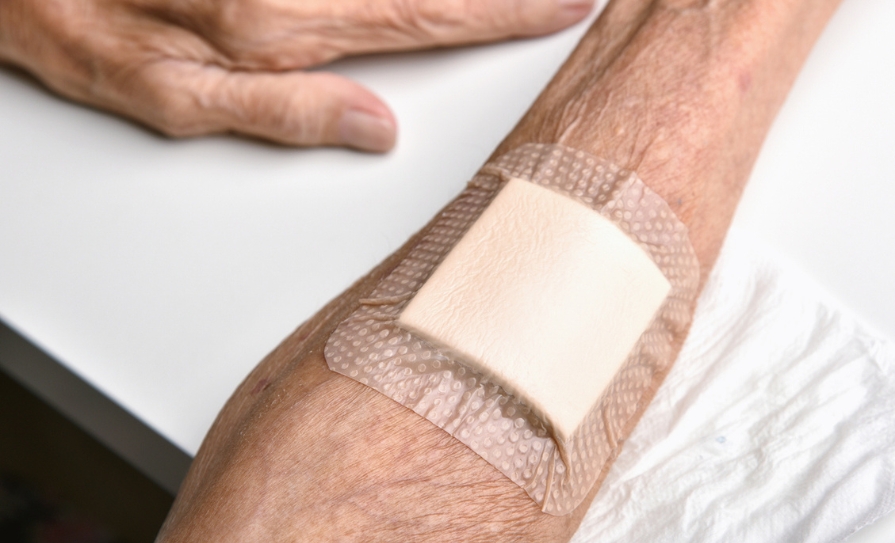Introduction
A wound is damage or disruption to the integrity of the skin or underlying tissue. Non-healing wounds affect a number of people in Ireland every year, particularly individuals aged 65 years and older. Chronic, non-healing wounds place a substantial burden on the Health Service Executive (HSE), costing hundreds of millions per year.
Wound care is an aspect of healthcare that involves practices aimed at promoting the healing of injuries to the skin and surrounding tissue. Pharmacists are accessible healthcare professionals who have an important role to play in wound care. This includes providing first aid, referring patients to
other healthcare practitioners where necessary, dispensing prescribed medications, offering patient education, and ensuring adherence to treatment. This article explores wound classification, good wound care practices, common conditions, wound assessment, clinical guidelines, and both pharmacological and nonpharmacological treatment approaches.
Background
Wounds can result from trauma, burns, surgery, or underlying conditions such as diabetes, immunological disease, and arterial or venous insufficiency. Wounds can be classified as either acute or chronic. Acute wounds typically follow a predictable healing pattern and timeframe. Examples of acute wounds include cuts, abrasions and surgical wounds. Chronic wounds stall during the normal stages of healing and typically fail to heal within three months. This delay may be due to underlying conditions, infection, or impaired healing processes. Examples of chronic wounds include diabetic ulcers, venous ulcers, arterial ulcers, and pressure injuries. Complications of wounds can include infection or delayed healing, which may result in discomfort, disability, reduced quality of life, or death. Effective wound care is necessary to prevent complications and support proper healing.
Wound care practices
Given the challenges of both acute and chronic wounds, effective care strategies are essential. Effective wound care is rooted in a patient-centered, evidencebased approach that considers the wound’s aetiology, phase of healing, and the patient’s overall health status. A comprehensive assessment forms the foundation for effective wound management. Accurate documentation is essential for monitoring progress and adapting treatment as needed. Infection prevention is vital in wound management to reduce the risk of infection and complications. Following the National Institute for Health and Care Excellence (NICE) guidance, strict hand hygiene, nontouch techniques, sterile gloves, and the use of sterile saline or potable water for cleansing are all recommended. Selecting an appropriate dressing is crucial to protect the wound and promote optimal healing conditions. Patient education on wound care techniques is also critical for effective management. Patients or carers may need to be equipped with the skills to change dressings correctly, monitor for signs of infection, and follow the treatment plan.
Assessment and diagnosis
A wound assessment tool known as TIME has been developed to support comprehensive wound evaluation. This framework considers four key factors: IN FOCUS | Wound care 48 VOL 26 ISSUE 8 : AUGUST 2025 Tissue, Infection/Inflammation, Moisture balance, and Edge of wound. TIME provides a systematic and structured approach to wound assessment. The assessment and diagnosis of various wound conditions necessitates a comprehensive evaluation of the patient’s medical history, wound characteristics, wound duration, previous trauma, and nutritional status of the patient. A detailed medical history is critical to identify underlying conditions that may impair wound healing, including diabetes, vascular disease and immunosuppression. Blood tests may be necessary to determine the patient’s overall health status and to evaluate any underlying conditions. A thorough wound assessment should include measurements of size, depth and location. The presence of necrotic tissue, exudate and signs of infection should also be evaluated. A wound culture may be necessary to identify any pathogens involved and to guide appropriate antimicrobial therapy. Imaging studies, including ultrasound imaging, computed tomography (CT) scans, magnetic resonance imaging (MRI) and x-rays can be useful in assessing deeper tissue involvement in chronic wounds. Finally, a nutritional assessment can help detect malnutrition, which may impede wound healing, particularly in elderly patients and those with chronic illnesses
Common wound conditions
Wounds can result from a variety of mechanisms and differ significantly in severity, complexity and management required. Acute traumatic wounds are typically caused by physical injury and generally follow a predictable healing process, with examples including cuts, lacerations and puncture wounds. Surgical wounds are intentional incisions made during medical procedures and when managed properly, also tend to heal in a predictable manner. Burns, which may result from heat, chemicals or radiation, often require specialised care to prevent infection and promote healing. Pressure ulcers (bedsores) commonly develop in immobile or elderly patients and result from prolonged pressure on the skin. Diabetic foot ulcers arise due to a combination of neuropathy and ischaemia — complications of diabetes — and can become chronic or lead to amputation if not managed properly. Venous leg ulcers are chronic wounds, typically appearing on the lower legs, caused by poor venous circulation that leads to inflammation and tissue breakdown.
Pharmacological treatment
Pharmacological interventions are essential in wound care to prevent or treat infection, manage pain, and support healing. They can also address underlying causes such as diabetes and vascular insufficiency. Pharmacological support may extend to systemic disease management, which may indirectly improve wound healing. Glycaemic control in diabetic patients significantly improves wound outcomes, with NICE guidelines recommending maintaining haemoglobin A1c (HbA1c) targets and reviewing antihyperglycaemic therapy in cases where wounds are slow to heal. Vascular risk factor management with statins, antihypertensives and antiplatelets is often used in patients with arterial ulcers or peripheral vascular disease to improve perfusion and support wound healing. The use of pharmacological treatments should be evidence-based and individualised based on the type of wound and patient-specific factors. NICE guidelines offer a framework for safe and effective pharmacological treatment, particularly for chronic wounds such as diabetic foot ulcers.
Analgesia
Analgesia is an important pharmacological consideration in wound care, particularly in burns, acute traumatic wounds, diabetic foot ulcers, and pressure ulcers. Pain is multifactorial and involves both physiological and psychological aspects. Patients with wounds often experience background pain, procedural pain or neuropathic pain. Despite its significant negative impact on healing and quality of life, pain is often overlooked in wound care. Proper assessment of pain — including its type, duration, and severity — is necessary to establish an effective pain management plan. NICE guidelines emphasise the need for regular pain assessment and the use of appropriate analgesia based on severity and underlying cause. Pain in diabetic foot ulcers may have either neuropathic or nociceptive origins. Diabetic foot pain should be assessed regularly and treated appropriately. Nociceptive pain may arise from tissue damage or infection. Paracetamol and nonsteroidal anti-inflammatory drugs (NSAIDs) may be used in the initial treatment if not contraindicated. Common NSAIDs include ibuprofen, diclofenac, naproxen, dexketoprofen, and meloxicam. These agents are important pharmacological interventions due to the inflammatory nature of chronic wounds. NICE guidelines for neuropathic pain in adults recommend the use of amitriptyline, duloxetine, gabapentin or pregabalin. Opioids are not considered first-line treatment but may be used in cases where other analgesics are ineffective. Caution is advised when using opioids, as they can mask symptoms of infection or ischaemia. Chronic opioid use is discouraged unless pain is refractory and managed under specialist care. Adverse effects of analgesics should always be considered. Common opioidrelated side-effects include respiratory depression, nausea, constipation, sedation and the risk of dependency. Analgesia is also a priority in burn care and should be tailored to the severity and location of the burn. Paracetamol and NSAIDs are typically suitable for mild burns, while moderate-to-severe burns may require opioids, particularly during dressing changes. Pharmacists have an important role in reviewing analgesic regimens and ensuring that breakthrough pain is effectively managed.
Antimicrobials
Infection control is one of the most important pharmacological considerations in wound care. Topical antibiotics are typically not recommended for routine use in most cases. This is due to the risk of antimicrobial resistance, a lack of evidence for improved outcomes, and the potential for contact dermatitis or delayed healing. Topical antibiotics may be considered in mild local infections where there is no involvement of deeper tissue and no systemic symptoms. Examples include with neomycin, mupirocin and fusidic therapies. However, the evidence is mixed, and while they may be used in selected cases, they are not routinely recommended. These agents are usually well tolerated, with local adverse effects such as erythema, itching, swelling and irritation being among the most common. Where systemic infection is suspected, a more aggressive approach with systemic antibiotics may be warranted. However, NICE guidelines strongly advise against their use in uninfected wounds due to the risk of antimicrobial resistance and adverse effects. Systemic antibiotics should be reserved for clinically infected wounds, which may present with symptoms such as pain, erythema, inflammation, purulent discharge, and fever. NICE guidelines recommend starting empirical antibiotics promptly, guided by the local antimicrobial formulary, likely causative organisms, and the patient’s allergy history. Culture and sensitivity testing can help confirm the diagnosis and refine antibiotic selection. Flucloxacillin, clindamycin, doxycycline and cephalexin are examples commonly used to treat wound infections. These are generally well tolerated, although common adverse effects include nausea, vomiting and diarrhoea. Antibiotic courses should be limited to the minimum effective duration, typically around seven days, and reviewed after 48-to-72 hours to assess clinical response. Treatment should be discontinued if there is no evidence of infection. Antimicrobial stewardship helps reduce resistance, minimise adverse effects, and support more effective wound care.
Non-pharmacological treatment
Non-pharmacological strategies are central to effective wound care and can be used in combination with pharmacological treatment. These approaches focus on optimising the wound environment, promoting tissue repair, and addressing the underlying factors that may impair healing. Effective healing involves a combination of strategies such as appropriate dressings, mechanical interventions like offloading and compression, debridement and lifestyle optimisation — tailored to the patient’s individual circumstances. Wound dressings are one of the most crucial aspects of wound care. They serve several essential functions, including maintaining a moist wound environment, managing exudate, protecting against infection, and promoting autolytic debridement. Sustained-release silver dressings may be used in burn care due to their broad-spectrum antimicrobial properties, although guidelines discourage routine use. Honey has antimicrobial, antiinflammatory and osmotic properties. Honey-based dressings may be used in burns and chronic wounds with lowgrade infection or to support autolytic debridement. NICE does not recommend honey dressings due to insufficient highquality evidence. However, they remain available and may be used as a secondline treatment in certain cases. Compression therapy is the mainstay of treatment of venous leg ulcers. NICE recommends compression bandaging or hosiery to improve venous return, reduce oedema and promote healing. Offloading is a key component of managing diabetic foot ulcers and pressure ulcers. Pressure at weight-bearing sites can be relieved using specialised devices or pressure redistribution techniques. Debridement is another critical component of wound care. This technique involves the removal of necrotic or sloughy tissue to reduce microbial load and stimulate healthy tissue regeneration. Methods of debridement include autolytic (using moisture-retentive dressings), mechanical, enzymatic or surgical approaches, with NICE highlighting the importance of debridement in diabetic foot ulcers. Negative pressure wound therapy is an emerging technique that applies suction to remove exudate and promote granulation tissue formation. Nutritional support and lifestyle factors should also be considered to optimise wound healing. Adequate protein intake, hydration, and essential vitamins and minerals — such as vitamin C and zinc — are necessary for tissue repair. Malnutrition, especially in elderly patients or those with chronic illnesses, should be addressed through dietary intervention or supplementation. Smoking cessation is also vital, as it improves oxygenation and supports the healing process.
Role of the pharmacist
Effective wound care should address the patient’s needs, promote normal healing, and prevent complications. Traditionally, wound management was handled by doctors, nurses or specialised multidisciplinary teams. However, pharmacists are now playing an increasingly significant role in wound care, extending beyond the traditional function of dispensing medications. Pharmacists can act as initial triage points — providing first aid, assessing wounds, and referring complex cases when necessary. They are heavily involved in the medication management of wound care, ensuring appropriate use of analgesics, antibiotics and wound healing agents, screening for drug interactions, adhering to antimicrobial stewardship guidelines, and ensuring treatment compliance. In addition, pharmacists educate and support patients in the correct use of medication, infection control practices and dressing changes. They can provide guidance on lifestyle modifications that enhance wound healing, including nutritional advice and smoking cessation support. With increasing integration into multidisciplinary care teams, pharmacists are uniquely positioned to contribute to improved outcomes in wound management.
References available on request







